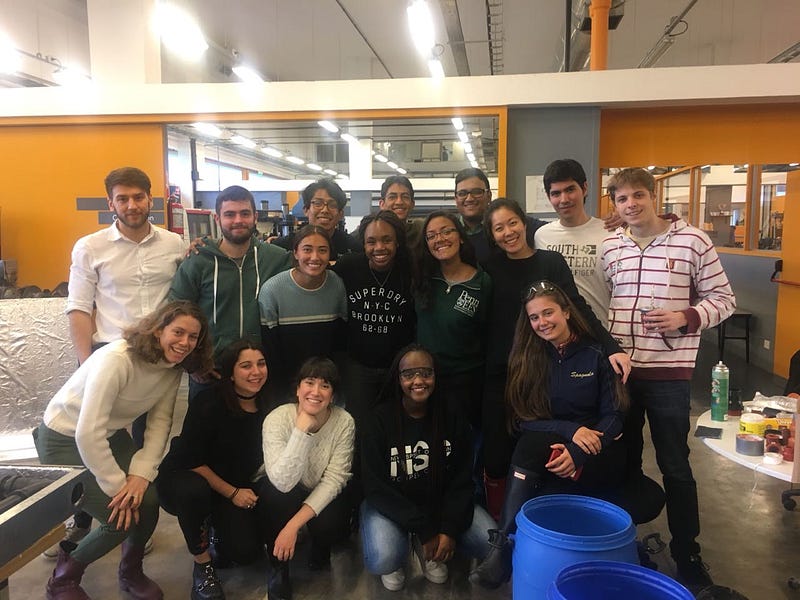Alexa Spagnola: Making Connections at the ITBA Lab

Alexa Spagnola is a sophomore studying electrical engineering who took part in the Renewable Energy global service learning program in Argentina this past summer. The program involves a semester-long survey of the technical and cultural knowledge necessary to prepare students for a three-week service trip to Buenos Aires. There, they work alongside students at the Instituto Technológico de Buenos Aires (ITBA) to partner with the community of La Plata and bring solar-powered water heaters to the resource-challenged area.
I feel at home in the machine lab. Since high school, I could always find my way around a bandsaw or a CNC lathe, and it is for that reason that I was so overjoyed when our group walked into the Parque Patricios ITBA building.
After dropping our belongings off, we were introduced to the people alongside whom we’d be working. Everyone, students and professors, gave us the friendly Argentine greeting of a kiss on the right cheek. While chatting with the ITBA students, they marveled at how young our group was, amazed that we would be able to keep up with them. In Argentina, students start college several years later than in the U.S., and many tend to take gap years as well. Their engineering degree is also a five-year program, and the majority of these students were in their fourth year. Thankfully, that age gap didn’t stop the jokes from flowing or the mate, the strong herbal tea customarily served in a communal cup, from being passed around.

One of the coolest things, in my opinion, was that ITBA had invited members of the community in La Plata, where our water heater was to be installed, to come help out in the lab. The four individuals, including one thirteen-year-old boy, were just as amazed at the machinery surrounding us as I was. They were genuinely excited to contribute and learn, and anxious to bring their newfound expertise back to their own homes. Their enthusiasm was infectious even when we were engaging in manual labor, and they insisted on taking pictures to share with friends while doing everything from sawing pipes in half to drilling through a steel frame.
This, to me, showed the Penn Engineering Renewable Energy program’s commitment to making lasting change. It is one thing to donate to a group, but it is entirely another to invest in an area’s development by showing residents how they can sustain helpful improvements. This wasn’t “by us, for them.” It was all of us, working together, each contributing something unique.
The experience was highly appealing to me as a freshman in electrical engineering. As with several other majors, most of my major-related classes will be taken sophomore year onward. That means that most freshman summer internship options were positions where I would have been underqualified or that weren’t fully relevant to my field of interest.
Instead, I chose to do something unique, something that enabled me to get hands-on experience in a true-to-life engineering setting while making positive change and visiting a foreign place. As an engineer looking to pursue several minors and possibly a master’s in four years, I may not have time to study abroad for a full semester, but I stand by the fact that international experience is paramount to any education.
The program includes a class in the spring semester before the trip where students prepare for both the technical and cultural challenges ahead, but there is only so much that you can learn secondhand about a different way of life. You must engulf yourself in it.
The language barrier whilst working was an interesting experience. I had taken five years of Spanish prior to coming to Penn, but was quite rusty in speaking since I hadn’t actively used my skills since. There was a moment in the lab when one of the women from La Plata had asked me a question and I found myself responding with elegant language, and I was so elated that I exclaimed, “MY SPANISH IS BACK!” I am definitely of the opinion that immersion is the key to functionality, and am so grateful for the experience of engaging in another culture’s language. The proof of this is that students and professors alike, without any Spanish background at all, were picking up common words and phrases and beginning to incorporate them. The human mind amazes me — once understanding becomes essential, it’s forced to adapt.
All in all, the lab wasn’t without its challenges. The ITBA students, although they could speak English, preferred to problem-solve in Spanish, while the Penn students gravitated toward English since many had no Spanish background at all. This made collaboration complicated, but possible with the right amount of effort. The two groups definitely had differing solutions to problems that arose, but I think this is a positive thing. It is easy to be stubborn and insist that your own way is best, but the entire experience in the lab was an exercise in seeking first to understand before passing judgment. Together, we were able to achieve some beautiful things — not just the development of a community, but the appreciation for one another.
